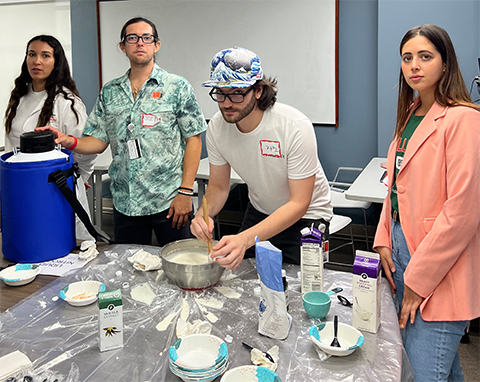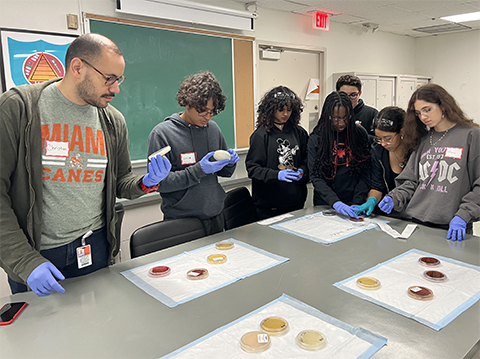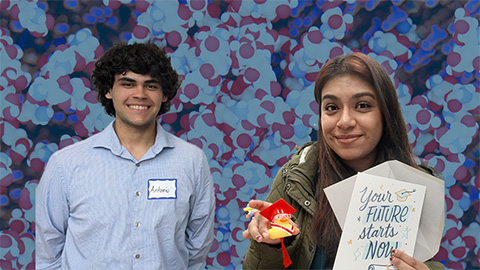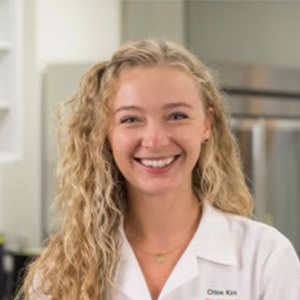Who did it?
How do you get high school students excited about scientific research? Summer camps, after-school science clubs, science museums, science fairs, field trips — what works?
I’m a fifth-year Ph.D. candidate in biochemistry and molecular biology at the University of Miami, and I recently partnered with my fellow graduate students Christian McDonald and Jessi Hersh and the American Society for Biochemistry and Molecular Biology to host 60 high schoolers for a DNA crime scene investigation.
Some background
In recent years, we’ve been testing ways to engage local high school students in the fun of science. In fall 2021 we partnered with Miami Edison High, a school in the city’s Little Haiti neighborhood with 100% enrollment of underrepresented groups, to volunteer at their after-school science club. In each session, a different graduate student came to talk about their research in general terms, and then we did a related science activity.

As we built rapport, the Miami Edison students asked more questions about what our research actually looked like. In spring 2022, we invited the 10 science club members to spend a day touring the University of Miami biochemistry labs and see science demonstrations such as a senior research scientist using various chemical compounds to change the color of flames. The high schoolers told us that removing barriers so they could see researchers are regular people in white lab coats helped them realize that they could pursue science as a career.
Their teacher told us that excitement around his science club and the recent field trip had spread, but many of the 1,000-some students at Miami Edison couldn’t stay after school to attend because they needed to take the school bus home or had other activities. Together, we hatched a plan to bring more students for another field trip to the university.
In fall 2022, 60 high schoolers from Miami Edison came for a day of science demonstrations, lab tours and learning about graduate student research projects, and the only cost to the school was school buses. It was a resounding success, but some students said the parts of the day felt disconnected from each other; it was learning and fun in small doses without an overarching theme or story. We resolved to fix that.
A new plan
Last spring, we received an ASBMB Science Outreach and Communication Grant and partnered with Alonzo & Tracy Mourning High School, also in Miami Dade County, to bring another 60 students to the university for a day of lab demonstrations, tours and talks — this time linked by a fictitious murder and gathering information from each activity to identify a culprit. The theme? Who did it? A DNA crime scene investigation.
Centering the event around the theme of DNA Day on April 25, we designed experiments we could incorporate into this murder scene and worked backward to the poisons and culprit backgrounds we needed.
The crime
A body was discovered at 8:37 a.m. The person has been dead for no more than 12 hours, and the cause of death was determined to be poison. The victim was identified as Taylor Smith, an accountant for a local law firm. In a text message sent at 5:19 p.m. the previous evening, Smith wrote that he was working late to finish an important report. A colleague said that Smith was working on an embezzlement report for the FBI.
All employees and building staff had access to the office where Smith was working, and no security footage was recovered. Many people had the motive and opportunity to kill Smith. We narrowed it down to five suspects who had a possible motive and an unconfirmed alibi. Our main suspects were Chloe, Laura, Joey, Maddison and Tate.
We told the students we needed them to interview the suspects and use the information they gathered, combined with forensic evidence, to identify the murderer.

The science
The students rotated through six demonstrations.
- DNA extraction and fingerprinting: Students learned how to extract DNA from a strawberry and differentiate types of fingerprints to eliminate potential suspects.
- Organs and autopsy: Medical student volunteers brought preserved organs for students to hold and narrow down the possible poisons used in the murder.
- Thin-layer chromatography: Students used TLC to further define the poison used in the murder.
- Blood typing: Students learned how blood typing works and what kind of blood was found at the crime scene.
- Bacteria plates: Students learned about bacteria linked to the crime scene and how various bacteria grow on agar plates.
- Suspect interrogation with liquid-nitrogen ice cream: Students interviewed the suspects about their alibi and motive while also eating and learning how liquid nitrogen can make ice cream.
After these demonstrations, the students had a final opportunity to interrogate suspects before a pizza lunch where they learned about high school summer research opportunities through the University of Miami and heard three-minute thesis presentations by Ph.D. students.
At the very end, we revealed the culprit.
Feedback and looking forward
This activity combined elements of the scientific process and application of scientific techniques with humanizing the people in lab coats and showing how science can be applied. Student feedback included “I loved being able to be in a lab and actually get to touch a real organ" and “a great experience and a look into something that I want to potentially study in the near future.”
To answer the question I posed at the start of this article — how do you excite kids about science research? — our answer is bringing students to see firsthand how research is done and humanizing the people behind the science, removing the misconception that only geniuses can do research and instilling the excitement of discovery and trying new things.
When I was in high school, my science classes seemed daunting and boring — reading dry textbooks to prepare for multiple-choice exams. That’s not how real-world science looks, and we aim to change that misconception. We plan to repeat this field trip with other local high schools, and we’ve already applied for university funding to cover a long-term investment in bringing the community to see what University of Miami research looks like.
More than 30 University of Miami undergrad, master’s, Ph.D. and medical students volunteered for this event, along with the organizing team of Jessica Hersh, Christian McDonald, Gili Lokiec and me.
One of the attendees told us, "I’d like to say to everyone who was a part of the crime scene investigation that they were all nice people and made the field trip way more astonishing."

Submit your proposal
Applications for ASBMB Science Outreach and Communication Grants are now being accepted. The deadline for this cycle is Oct. 31, and results will be announced in January. Learn more and apply.
Enjoy reading ASBMB Today?
Become a member to receive the print edition four times a year and the digital edition monthly.
Learn moreGet the latest from ASBMB Today
Enter your email address, and we’ll send you a weekly email with recent articles, interviews and more.
Latest in Education
Education highlights or most popular articles

Summer research spotlight
The 2025 Undergraduate Research Award recipients share results and insights from their lab experiences.

Debugging my code and teaching with ChatGPT
AI tools like ChatGPT have changed the way an assistant professor teaches and does research. But, he asserts that real growth still comes from struggle, and educators must help students use AI wisely — as scaffolds, not shortcuts.

How AlphaFold transformed my classroom into a research lab
A high school science teacher reflects on how AI-integrated technologies help her students ponder realistic research questions with hands-on learning.

Writing with AI turns chaos into clarity
Associate professor shares how generative AI, used as a creative whiteboard, helps scientists refine ideas, structure complexity and sharpen clarity — transforming the messy process of discovery into compelling science writing.

How undergrad research catalyzes scientific careers
Undergraduate research doesn’t just teach lab skills, it transforms scientists. For Antonio Rivera and Julissa Cruz–Bautista, joining a lab became a turning point, fostering critical thinking, persistence and research identity.

Talk nerdy to me: Communicating research that matters
Master science communication: learn to engage the public, work with the press and explore new careers — from consulting to media — through ASBMB’s Art of Science Communication course.

